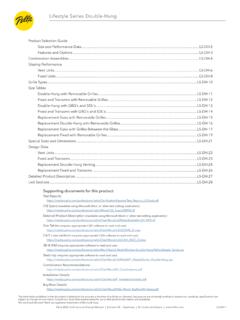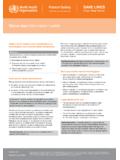Transcription of WESTERN POWDERS, INC - Hodgdon
1 double -Base Gunpowder WESTERN Powders, Inc. Issue Date: 04/23/2020 Safety Data Sheet according to OSHA HazCom Standard (2012) requirements Section 1 - Identification of the Mixture and of the Company Product Names: Nitro 100 NF, Ramshot Zip, Accurate #2, Accurate #5, Ramshot Silhouette, Ramshot True Blue, Accurate 4100, Ramshot Enforcer, Ramshot X-Terminator, Accurate 2230, Ramshot TAC, Ramshot Hunter, Ramshot Big Game, Ramshot Magnum, Accurate 2520, Ramshot Competition, Accurate #7, Accurate #9, Accurate 1680, Accurate 5744, Accurate 2200, Accurate 2460, Accurate 2700, Accurate Magpro, Accurate 11FS, Accurate TCM, Ramshot LRT Trade Names and Synonyms: Spherical gunpowder, Ball powder , double -base gunpowder. Relevant Identified Uses: Product is intended for use in smokeless propellant applications only. Distributed By: WESTERN POWDERS, INC. Box 158 Miles City, Montana 59301 Telephone: (406)234-0422 Fax: (406)234-0430 Website Email: Emergencies Chemtrec 1-800-424-9300 Section 2 - HAZARD IDENTIFICATION Classification of the Mixture: Explosives Division GHS Classification: Signal Word: Danger Hazard Statements: H203 Explosive; fire, blast or projection hazard.
2 H302 Harmful if swallowed. H319 Causes serious eye irritation. H317 May cause an allergic skin reaction. H371 May cause damage to organs (circulatory system, blood, kidneys, liver) through prolonged or repeated exposure. Precautionary Statements Prevention P210 Keep away from heat. P240 Ground or bond container and receiving equipment P250 Do not subject to shock or friction. P260 Do not breathe dust. P280 wash thoroughly after handling. P270 Do not eat, drink or smoke when using this product. P281 Wear protective gloves, protective clothing and eye protection. Response P370 Explosion risk. In case of fire: Evacuate area. Use water to extinguish. Do NOT fight fire when fire reaches explosives. P312 If swallowed: Call a poison control center or doctor if you feel unwell. P330 Rinse mouth. P305 If in eyes: Rinse cautiously with water for several minutes.
3 P338 Remove contact lenses, if present and easy to do. Continue rinsing. P303 If on skin: wash with plenty of water. P337 If eye irritation persists: Call a doctor. P333 If skin rash persists: Call a doctor. P363 wash contaminated clothing before reuse. Storage P410+412 Store in a well-ventilated place away from direct sunlight. P404 Keep container tightly closed. P420 Store away from ignition sources. Disposal P501 Store and dispose of container, waste and residues in accordance with all applicable legal and regulatory requirements. Section 3 - COMPOSITION / INFORMATION ON INGREDIENTS Substances: Product is a mixture. Section 4 - FIRST AID MEASURES Inhalation Remove to fresh air. If not breathing, institute rescue breathing. If breathing is difficult, ensure airway is clear, give oxygen and continue to monitor. If heart has stopped, immediately begin cardiopulmonary resuscitation (CPR).
4 Keep affected person warm and at rest. Get immediate medical attention. Eye Contact Do not rub eyes. Immediately flush with plenty of water for up to 15 minutes. Remove any contact lenses and open eyelids wide apart. If eye irritation develops, call a physician. Skin Contact Immediately wash exposed skin with plenty of soap and water while removing contaminated clothing and shoes. May be absorbed through the skin in harmful amounts. Call a physician if you feel unwell. CAS Number %[Weight] Name 9004-70-0 50-100 Nitrocellulose 55-63-0 0-42 Nitroglycerin 84-74-2 0-10 Dibutyl Phthalate Not Available 0-10 Polyester Adipate 85-98-3 0-10 Ethyl Centralite (diethyldiphenylurea) 8050-09-07 0-5 Rosin 13114-72-2 0-3 Akardite II 7757-79-1 0-3 Potassium Nitrate 7778-80-5 0-3 Potassium Sulfate 141-78-6 0-2 Ethyl Acetate 141-78-6 Diphenylamine 86-30-6 N-Nitrosodiphenylamine 18282-10-5 Tin Dioxide 1317-65-3 0-1 Calcium Carbonate 7782-42-5 0-1 Graphite wash clothing before re-use.
5 If clothing is to be laundered, inform the person performing the operation of the contaminants hazardous properties. Ingestion Rinse mouth thoroughly with water and give large amounts water to people not unconscious. Do NOT induce vomiting. Get immediate medical attention. Do not give anything by mouth if the person is unconscious or if having convulsions. Most important symptoms and effects, both acute and delayed. Eye irritation. Symptoms may include itching, burning, redness and tearing. Skin contact may cause redness and pain. Ingestion may cause gastrointestinal irritation, nausea, vomiting and diarrhea. High concentrations of dust may irritate throat and respiratory system and cause coughing. A drop in blood pressure, headache, cyanosis and mental confusion may result from nitroglycerin in the product. Indications of any immediate medical attention and special treatment needed.
6 Provide general supportive measures and treat symptomatically. Keep victim under observation. Section 5 - FIRE FIGHTING MEASURES EXTINGUISHING MEDIA: Large volumes of water should be applied as quickly as possible from automatic sprinklers or fire hose. Unsuitable extinguishing media Do not use water jet as an extinguisher, as this may spread fire. Special Hazards arising from the substrate or mixture. Toxic vapors/gases may be formed during a fire. Combustion products vary depending on fire conditions and other combustibles present. The predominant products will be carbon dioxide and oxides of nitrogen, Under some conditions, methane, carbon monoxide, irritating aldehydes and carboxylic acids, and hydrogen cyanide may be formed. Special protective equipment and precautions for firefighters Self-contained breathing apparatus (SCBA) and full protective clothing must be worn in case of fire.
7 This includes, but is not limited to, impervious boots, gloves, hard hat and chemically impermeable suit. Fire-fighting equipment/instructions Fires involving smokeless propellant should NOT be fought unless extinguishing media can be applied from a well protected ( behind a berm or barricade) and distant location from the point of fire. Specific methods Evacuate personnel to a safe area according to pre-determined evacuation plan. Use standard firefighting procedures and consider the hazards of other involved materials. General fire hazards Explosive; fire, blast or projection hazard. Section 6 - ACCIDENTAL RELEASE MEASURES Personal precautions, protective equipment and emergency procedures. Keep unnecessary personnel away. Eliminate all ignition sources. Use only non-sparking tools. Wear appropriate protective equipment and non-flammable or flame retardant clothing during clean-up.
8 Avoid inhalation of dust. Use a NIOSH/MSHA approved respirator if there is a risk of exposure to dust/fumes at levels exceeding the exposure limits. Do not touch damaged containers or spilled material unless wearing appropriate protective clothing. Ensure adequate ventilation. Local authorities should be advised if significant spillages cannot be contained. For personal protection, see section 8 of this SDS. Methods and materials for containment and cleaning up Avoid dispersal of dust in the air ( clearing dust surfaces with compressed air). Clean-up spills immediately using non-sparking utensils. Wet down spilled materials prior to initiating clean-up and keep material wet until ready for disposal. Avoid contamination of water bodies during clean up and disposal. This material is heavier than water. Create an overflow dam with filtration capabilities to retain material.
9 Collect dust using a vacuum cleaner equipped with HEPA filter. Large Spills: Sweep, shovel or vacuum up spillage and collect in suitable container for disposal. For a spillage into water: where possible, remove any intact containers from the water. Clean contaminated surfaces thoroughly to remove residual contamination. Never return spilled material to original containers for re-use. For waste disposal, see section 13 of this SDS. Section 7 - HANDLING AND STORAGE Precautions for Safe Handling Do not handle until all safety precautions have been read and understood. Do not subject to mechanical shock. Avoid exposure to sunlight or artificial ultraviolet light. Minimize dust generation and accumulation. Provide appropriate exhaust ventilation. Avoid breathing dust. Avoid contact with eyes, skin and clothing. Do not taste or swallow. Wear appropriate personal protective equipment.
10 Observe good industrial hygiene practices. Smokeless powder contains stabilizers and deteriorates very slowly under proper storage conditions. Old smokeless powder should be checked for deterioration regularly. Deteriorating smokeless powder produces an acidic odor and may produce reddish-brown fumes. Dispose of deteriorating smokeless powder through, for example, controlled open burning in small quantities (products should be submerged in water until burned). Smokeless powder should not be exposed to excessive heat, as this can accelerate deterioration. Deterioration produces an acidity that accelerates further reaction and has been known, because of heat generated by the reaction, to cause spontaneous combustion. Conditions for safe storage, including any incompatibilities Store at 21 C (70 F), 50% relative humidity (decomposition becomes measurable above 50 C (122 F).)







